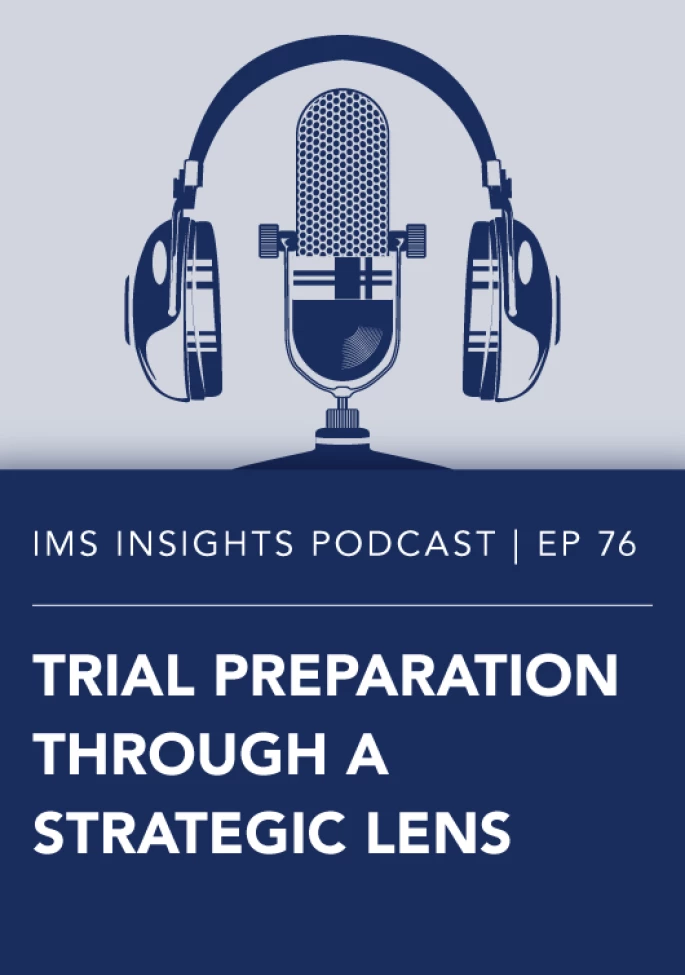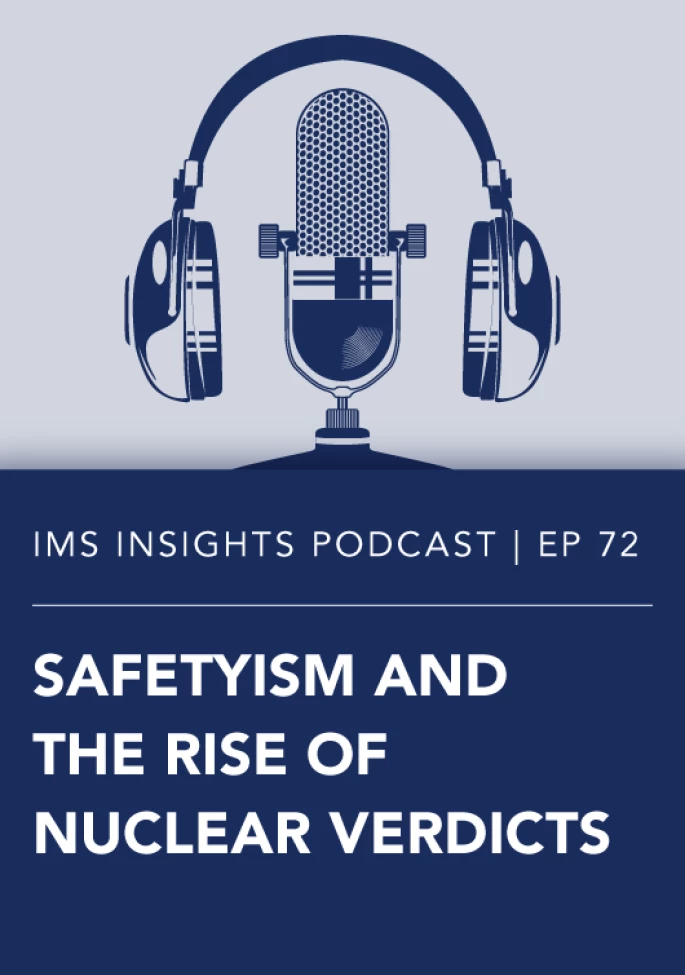Adam Bloomberg (Intro): Welcome to the IMS Insights Podcast, where the nation’s leading experts in litigation trends share their insights.
Chris Dominic: Welcome everyone. I'm Chris Dominic, a senior strategy and jury consulting advisor at IMS. We partner with trial lawyers to help sharpen litigation strategies and give them an edge in the courtroom. Today, I'm chatting with my colleague, Michelle Cooper, a trial consultant here at IMS. As a litigator specializing in securities cases with a methodological approach to courtroom presentations, Michelle bridges the gap between legal strategy and visual communication to deliver compelling client solutions. We're here to dive into a critical topic in securities litigation: how to use themes and analogies to make complex cases more accessible and persuasive. Michelle, welcome. It's great to have you here.
Michelle Cooper: Thank you so much. It's great to be here. I have thought about your job a lot because I thought, all right, she's at some point a litigator, she's working on cases, and at some point, something had to enter your mind where you thought, "I really want to work on graphics or strategic." How did that happen?
Chris Dominic: Right. Every young lawyer's mind just kind of hits one day and goes, "I want to pivot a little bit and do something a little more creative." Well, that was primarily it, right? So I studied to be a lawyer. I did securities fraud litigation for about three years. And I realized that, you know, writing briefs, reading briefs, as interesting as they are, I wanted to do something more creative, something more visual. And I realized that trial graphics is exactly that perfect mold and that perfect mesh between what I do as a litigator, which is showcase the law as best as it can to advocate on behalf of my clients, but also do it in a way that is interesting, entertaining, gravitating, and it sort of helps engage the viewer and really get in touch with the law. And so that's kind of why I kind of transferred over to visual advocacy. I did a little bit of a mixture between jury consulting and visual advocacy before I came over to IMS. And I realized, yeah, visual is where I want to be. And it's the best way to tell a story.
Michelle Cooper: Well, I'll tell you, I think in securities cases, it's just such an essential component in particular. I am curious about this theme issue in terms of the demonstrative being a strategic product, right? Making sure that the case comes in the way you want it to and that you're staying consistent with the narrative that you've got. What are some of the ones, themes that is, that you see in operation most often? What are you working with these days?
Chris Dominic: Absolutely. And even on the idea of themes, you know, it's very much a team effort. It's very collaborative, especially between, you know, the jury consultants and the trial consultants and visual ad. We have to build those themes together. If you guys don't have a great theme, there's nothing our graphics can work off of. So it all has to be this one cohesive kind of timeline and story. On that side of things, especially for the securities-based cases, on the plaintiff side, we often try to emphasize this idea of trust and betrayal. These investors are victims. They were misled by this evil, powerful corporation. And you really want to showcase that. But on the flip side for the defense, you want to say that the company was being reasonable. They were just being, you know, a reasonable business that were engaging in common practices. They, you know, the forward-looking statements were taken out of context. They were never meant to be intentionally misleading because there are certain statements that are considered puffery and they're kind of allowed to be said and just to bolster kind of the company's repertoire and things like that. So you really want to lean more on that side of things. But thinking about all that stuff, how about you, Chris? What about you? What's your experience?
Michelle Cooper: Well, okay. So in my world, on the plaintiff's side, I think you're right. It's really common that you're dealing with a broken promises theme. And particularly if you have to deal with something like breach of fiduciary duty, that conceptually is very difficult. And often we need some visual way to get people to struggle with the randomness in their mind of what that is. I mean, it's really its own philosophical concept if you think about it. And then on the defense side, often we're dealing with buyer's remorse or some sort of hindsight bias. And again, that's not always something that people can easily access without something visual. Often we're trying to use some sort of causation argument within that theme to try and help make it work. How does this relate to analogies for you?
Chris Dominic: That's my favorite word, analogies. I mean, I love, you'll talk to a lot of lawyers and they either love it or they hate it, right? So they either think in analogy or they're like, please steer clear. I want to stick to the law and the facts as it is. But I think analogies are so critical, especially in these kind of securities and financial type cases, because they bridge the gap between complex legal principles and real-life experiences. And jurors, as many lay people, are not experts in securities law. Even some lawyers aren't really experts in it, but they understand everyday comparison. So it's really a great idea to focus in on a good analogy that can make that case a little bit more accessible and definitely more memorable. A couple of those types of examples for me would definitely have to be like the cherry-picking analogy. I've seen those done in a lot of briefs and we like to bring those into our graphics, right? Because the defense is, you know, or the plaintiff side, but it can be used on both sides. It's, you know, you're accusing the other side for choosing only favorable pieces of evidence to display and emphasize while ignoring the rest of the story. And so you're just picking the best cherry to showcase to the jury and to the judge. So you really want to call that out and people are going to remember that. They're going to be like, didn't they cherry-pick that factor or something like that? And that's what you want them to take back. Another great example would be the present example, right, where you've got kind of like these two presents that on the outside they look identical. You open up the first present, and it's a promise of this beautiful, valuable gift, money, whatever you'd like to put in there. And then the other one is an empty box. And the idea of that is to show misleading statements or a misleading story here, where you promised one thing, but you were giving us nothing. And the last one, which is my personal favorite on this would be like a tightrope analogy, right? Where you're trying to, especially in the securities realm, the investors are depicting as walking this financial tightrope, you know, kind of unbalanced, uneasy, and they're really relying on the corporations and the leaders of the corporations to give them credible information. But yet there's fraudulent or misleading statements being said or corporate actions taken that cuts that rope so those investors fall and you know that can actually be pushed up one more step and you can bring in the securities laws to say that they're here to protect those investors that's why we rely on the securities laws and that's like a safety net that will catch those investors when they fall but you know going through all those types of analogies what's your favorite go-to analogy I guess specifically maybe for no causation
Michelle Cooper: Yeah, so on no causation, I think we played with three, depending on the case. There is the bridge that has three sections, right? The middle section is where the causation is. And if it's not there, then you don't get to the other side. The reason why that's so important is because it's really, really normal for people to think if there's something that seems wrong, then there must be some cause of action, right? Like there's liability. And if you're defending, you have to make it really clear to people that causation has this extra, it's an extra step. And the thing that's also tough is you're not always going to get that on your verdict form or your jury instructions, right? So the other one, we've used the broken chain link, right? The chain is only as good as its weakest link. You know, maybe causation is in the middle and that's the weak link. And then, of course, in some cases, it makes most sense to use like the dominoes, right? Like nothing ever tips the first domino. That kind of thing. Just something to help people remember it. Maybe they even draw it again. That sort of thing. That has always been those have been the three things that we typically work with when we're on the defense side in particular. But what about like flip it back? What about like what you've seen more in the plaintiff cases or juror bias, anti-corporate work, that kind of thing?
Chris Dominic: Sure. Sure. Absolutely. You know, we see like nowadays jurors are very skeptical of big corporations. You know, it's very it's this key of like profits over people mindset that is it kind of transcends the product liability cases. And it does find itself into securities cases specifically because you are usually suing against these big corporations that are. you know, on the securities exchanges and they are marketing themselves as these great companies. And yet people know that that isn't the case, right? We only care about money here. We don't care about the little people. And so they're gonna be more inclined to side with plaintiffs. If you're thinking about that kind of idea and that theme. Sometimes it can be a little back and forth in the sense that there are jurors that can admire big companies like Apple or Google, right? Like we all use Apple products. And so they tend to side with those or they might be a little hesitant because they just like the products. They don't want to see them as bad or give up on them. But these perceptions are definitely a key influence over verdicts. But specifically talking about those verdicts, have you also seen this in your practice?
Michelle Cooper: Well, yeah, I mean, certainly the whole decline of trust in corporations is pretty widely known at this point, but the way it tends to get dealt with is we're going to have to really work hard to show the business context of corporate statements. We sort of stopped trying to prove that corporations care, and that sounds terrible, but really all it means is we started to realize a while back that you're better off figuring out if people are already wired to believe that corporations just focus on profits and money and shareholders, well, then how can we make sure that the action that the plaintiffs are trying to prove is bad for business? Because when you can kind of have an intersection of, OK, sure, they do good works, but we're not going to try and convince people that they're saints. We're going to show them how, for example, you know, the discrimination they're talking about is actually bad for business or this particular securities practice in this case that we're talking about, this would never be a good idea because it'd be terrible for business. And that kind of thing is from a jury consulting perspective, how we often deal with that. But back to you, what do you do with all the dense financial records? I mean, securities cases that I've worked on, there's just, there's spreadsheets everywhere. How do you handle that?
Chris Dominic: Oh, absolutely. And that's why we say visuals are key for securities cases or these financial cases. You know, the concepts are incredibly complex and specifically, like you just mentioned on the data, you know, digesting all of the data that's coming in. Right. They involve all those financial records. A lot of times the securities, you know, filing records, write the annual reports, things like that, which are just hundreds of pages long. And so you need to really focus on making a clear, simple visual, which is why I was so keen on the analogies, but something that kind of displays it and it doesn't make it too busy over the top, but it's going to just track those key arguments and focus in on the important points. And we tend to do this by focusing on three major groups of graphics. So the number one, which I think is probably everybody's favorite for good reason is a timeline. right? So you really want to, you love a timeline? Yeah, timelines are great. It's the best way to kind of tell your entire story the way that you want to do it and focus in on the points you want to focus in. And it kind of includes, you know, statements versus stock price reactions, right? Like you can say, you can show when a company or a CEO has made a public statement or a public disclosure, and then at the same time, simultaneously track when a stock price might have reacted to it, right? And so when there's an overlap, there's your point right there, right? That might lead to explaining a loss causation argument or something like that. And so it's really helpful. Something else that's helpful is when you go more on the kind of conceptual realm, you talk about maybe those loss graphics. Right. Like which kind of parallels damages. But, you know, you want to talk about different stacks of cash and, you know, just to visualize how much money is actually at stake here, how much money was lost and to actually show that money. Right. You can do that in pellets versus the size of a human being or things like that just to show comparison. and another one is kind of what I mentioned earlier which is those metaphorical or analogy type visuals right the tight walker showing investment risk and things like that so those are really helpful to tell that story to paint a picture and you know they might not remember all those spreadsheets or points but they're going to remember the timeline and where it overlapped or you know the tightrope they're going to remember those and take those into the deliberation room. But you know, Chris, have you seen that work for you by any chance? Like kind of that idea?
Michelle Cooper: Well, I mean, the reason why I'm such a big fan of the timeline, one, is because every time we do a mock trial and there isn't one, some juror just says, I really needed a timeline. And I think I know why. Because over the years, I've been watching the way jurors deal with And one of the things that I hear attorneys sometimes say is, this doesn't really matter anyway, because it's not going to go back to the jury. And I always think to myself, that's not what I'm seeing. What I'm seeing is there's this doodler who's juror number three, and the doodler is doodling your timeline. And maybe he's only doodling or she's only doodling the key that they like about your timeline, but that's still something that's going to allow them to basically be an advocate for you when you're not around. And that's a huge piece of jury persuasion. So I've always been a big fan and I think it's rare that you have a case where you don't need a beautiful visual strategically aligned thematic timeline. But let me ask you, do you have any, just as we wrap this up, do you have any like key visual examples of anything that you really just love?
Chris Dominic: Yeah. I mean, I would say some of my favorites are doing like side-by-side comparisons, right? Like you kind of show either it's in the format of like a before and after, or it's what was promised, what was delivered, or it's, you know, what could have been and what's currently happening, you know, just really showing like front and center on one slide or one visual, you know, the story either being painted on one side and what's the true story right things like that and and that really kind of goes back and it sticks with jurors right the real idea here is we want things to stick with the jurors when they go in that deliberation room because we're not there anymore to advocate or to tell our story anymore obviously you know in mock trials we get that lovely uh gift to be able to see inside a jury's mind but you don't get to see that actually in trial So you want to use those relatable analogies. For example, like one of my favorites, like I mentioned earlier, was the present, right? The two presents, again, it's that comparison where one present, you know, what was promised, open it, lots of money, good things, right? Like everything's great. And then the other present is just empty or just, you know, dust, nothing's there.
Adam Bloomberg (Outro): Thank you to our guest for speaking with us today. To discover how the IMS team can help give your case an edge, check out imslegal.com or shoot us an email at contactus@imslegal.com. IMS has served trusted law firms and corporations worldwide for more than 30 years in over 45,000 cases. As a strategic partner for the full case lifecycle, our integrated teams provide specialized advisory support, expert witness services, litigation consulting, visual advocacy, and presentation technology to elevate strategies and protect hard-earned reputations. Learn more at imslegal.com.








